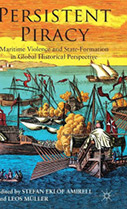Persistent Piracy: Maritime Violence and State-Formation in Global Historical Perspective

Editors: Stefan Eklöf Amirell and Leos Müller
Publisher: Basingstoke, UK; New York: Palgrave Macmillan, 2014. 232p.
Reviewer: Bruce A. Elleman | September 2015
Just as beauty is in the eye of the beholder, so—apparently—are pirates. This edited volume of eight essays largely ignores the mechanics of piracy (go elsewhere if you care to read about ships, sailing, sailors, or even the act of one ship forcibly taking another ship) and instead focuses on the social, economic, and political factors that led to the rise of piracy throughout most of recorded history, from the Greeks through to the Romans, the Vikings, in the Far East, and then up to the contemporary period along the shores of Somalia.
In Chapter 1, Philip de Souza discusses how in classical piracy most violent acts were directed from the sea against the land, with the goal of acquiring goods, livestock, or people, either for ransom or as slaves. Long considered a legitimate form of warfare, it was only, beginning with the Greeks—and then carried to ultimate fruition under Roman law—that piracy was condemned as “illegitimate.” This is the origin of a “moral and political imperative to defeat pirates” (41) that eventually transitioned into the legal concept hostis humani generis (an enemy of all mankind) during the time of Hugo Grotius.
In Chapter 2, Neil Price explains how over almost four centuries, from their first recorded raid in June 793 until the mid-11th century, the Scandinavian tribes collectively known as the Vikings coalesced into a nation-state. Beginning as small-scale raiders, within fifty years a number of separate fleets—referred to as the “Viking hydrarchy”—spread out and devastated much of northern Europe, invading and securing half of the British Isles and establishing the Viking city-state of York. Rather than being destroyed from the outside, a process of state-building, plus the gradual conversion to less warlike Christianity, meant that “Viking piracy quite simply outlived its usefulness and viability in the changing Europe of the Early Middle Ages” (65).
Chapter 3 is an examination by Wolfgang Kaiser and Guillaume Calafat of the gradual institutionalization of Corsairs in the Mediterranean during the 14th-16th centuries. The major difference, they argue, between a simple pirate and a corsair was a single piece of paper, in this case a letter of marque issued by one state allowing commerce raiding against another state. The addition of this piece of paper made the activity known as corsairing, “institutionalised, legitimate and regulated violence” (72) and in fact over a period of several centuries contributed to the development by European powers of “the earliest forms of regulation and protection of the freedom of navigation and trade” (85).
In Chapter 4, James K. Chin discusses 17th century Chinese piracy by the people of Fujian, known as Hokkiens. Zheng Zhilong, his son Zheng Chenggong, and grandson Zheng Jing, were in control of a complicated organization that took on many characteristics of a state, including strong centralized administration, its own flags and money, and, after 1662, self-proclaimed sovereignty over the island of Taiwan. At its height, the Zheng family business had almost 500,000 personnel operating five hundred pirate ships. For almost half a century, between the 1630s until 1683, the Zheng family had a virtual monopoly on China’s “overseas maritime trade” by delicately balancing relations with “the Japanese, Dutch, Portuguese and a number of South East Asian peoples” (102). Following Zheng Jing’s death in 1681 however, a power struggle gave the Qing dynasty’s Kangxi emperor an opportunity to strike out. In October 1683, the Zheng family turned over control of Taiwan to Admiral Shi Lang, who commanded an invasion force of 300 ships transporting 20,000 troops.
In Chapter 5, Robert J. Antony shows how Chinese pirates were crucial to the formation and survival of the Tay Son state in Vietnam. Beginning in 1771, the rebellion spread from southern Vietnam and, by the late 1780s, controlled most of Vietnam. Chinese pirates made up the bulk of the Tay Son navy, and supported the rebellion until its defeat in 1802. In return, the Tay Son offered the pirates “safe harbours, ships and weapons,” not to mention a ready market for their booty (117). Most importantly, connections with the Tay Son gave the status-conscious Chinese pirates a certain state legitimacy beyond being mere sea bandits. The pirates, for their part, not only fought alongside the Tay Son in battle, but provided critical funding in a “plunder-based political economy” that was reliant on “politically organised maritime violence” (127).
In Chapter 6, David J. Starkey and Matthew McCarthy talk about British privateers in the Atlantic from the 16th to the 19th century. Discussed in terms of a black-to-white spectrum of events, with piracy on one end and prize-takers at the other, there were many shades of grey in the middle, including Caribbean buccaneers and colonial “insurgent privateers” seeking independence from a European overlord (135). Likewise, business models varied widely, from paid crews to those who received no pay if prizes were not taken, as did the British government’s reaction to privateers, sometimes stimulating more privateering during times of war, sometimes adopting a neutral attitude, and at other times—in particular after the Napoleonic wars—working to abolish privateering by means of the 1856 Declaration of Paris.
In Chapter 7, Sulu piracy during the 18th and 19th centuries is discussed by James Francis Warren. Piracy existed in Southeast Asia long before the appearance of Europeans, but it increased dramatically after their arrival, in part because Western trade disrupted local commercial markets, but also in part because of the booming European-sponsored Sulu trade with China. The Iranun pirates in the southern Philippines attempted to exploit this situation, not just using the sea to raid Malay traders but also in search of slaves for “commodity procurement” of highly sought after products from both land and sea, including birds’ nests, tripang (sea cucumbers), shark fins, and pearls. Spain initially profited from this trade, but it turned against the slave-raiders beginning in 1848, when the introduction of steam-powered gunships led to the destruction of the Balangingi fortress. Fifty years later, the year 1898 saw the “final economic and political collapse of the Sulu trading-raiding sphere” (172).
In Chapter 8, 21st century piracy is described by Stig Jarle Hansen as simply one of the costs of doing business in the modern world. Many piracies occur in constricted waters, for example in the Gulf of Aden and the Malacca Strait, where naval forces can successfully deter attacks. To inhibit piracy in other parts of the world, however, ships must change their own behavior, such as going faster to prevent illegal boarding, or hire private security forces. To solve piracy one must look to the land. While poverty and the impact of illegal fishing may have contributed to Somalis undertaking piratical activities, many other countries with similar problems have not taken this same path. Weak states appear to allow piracy to prosper, but again not all weak states harbor pirates. To really solve piracy would require a combination of “state-building, anti-corruption efforts and police development,” but in a stateless society—such as Somalia—the very lack of an effective government can inhibit progress (184).
Spanning over 3,000 years, “persistent piracy,” as defined by Stefan Eklöf Amirell and Leos Müller, is composed of cases where “sporadic, small-scale piratical activity has developed into well-organized, enduring and large-scale ventures that often seriously threaten the security and even the very existence of neighbouring states or start to develop into states themselves” (1). In this context, this book’s essays include historical examples where piracy led to some form institutionalization, usually within the context of states. Six necessary characteristics of this type of piracy would appear to be secure land bases, access to markets, piracy being conducted on a large scale (as versus opportunistic attacks), a high degree of organization, the formation of state institutions, and finally the length of time the activities persist, from decades in some cases to centuries in others. Existing states can either partly or fully sponsor piracy, accept it, or suppress it, with the gradual growth of state institutions tending toward greater and greater regulation and finally suppression.
While the authors’ arguments are certainly thought-provoking, and often seem quite persuasive, their decision to include the entire range of maritime crime—from private acts of piracy on the one hand to state-sponsored commerce raiding on the other hand—obscures many fundamental differences. While Sweden (where both editors reside) might be able to argue Viking piracy sponsored state-building, many of the other case studies in this book are less convincing: for example, the Hokkien, Tay Son, and Sulu pirate empires were all destroyed. To give pirates credit for state-building would be parallel with lauding the American gangster Al Capone for creating the modern American police force. Constructive recommendations on how to eliminate piracy, for example by making greater use of professional navies, are barely touched upon.
Bruce A. Elleman, William V. Pratt Professor of International History, U.S. Naval War College


